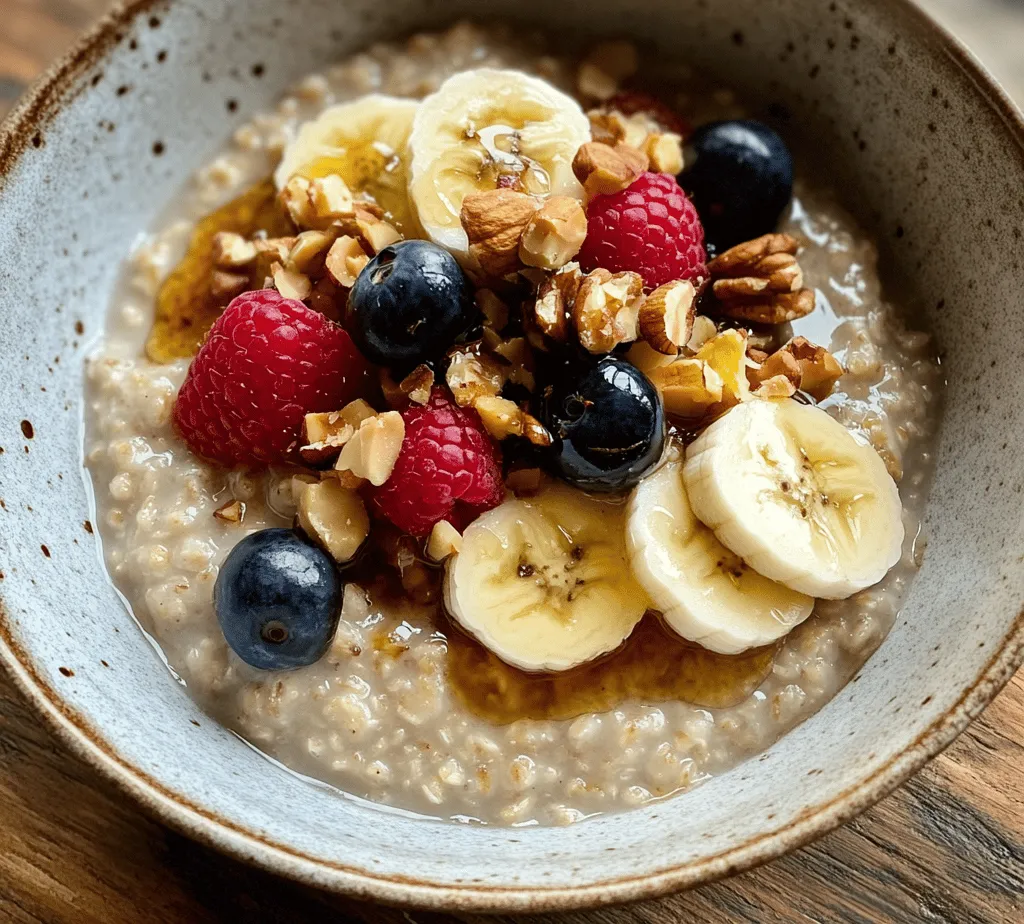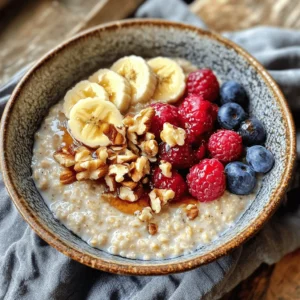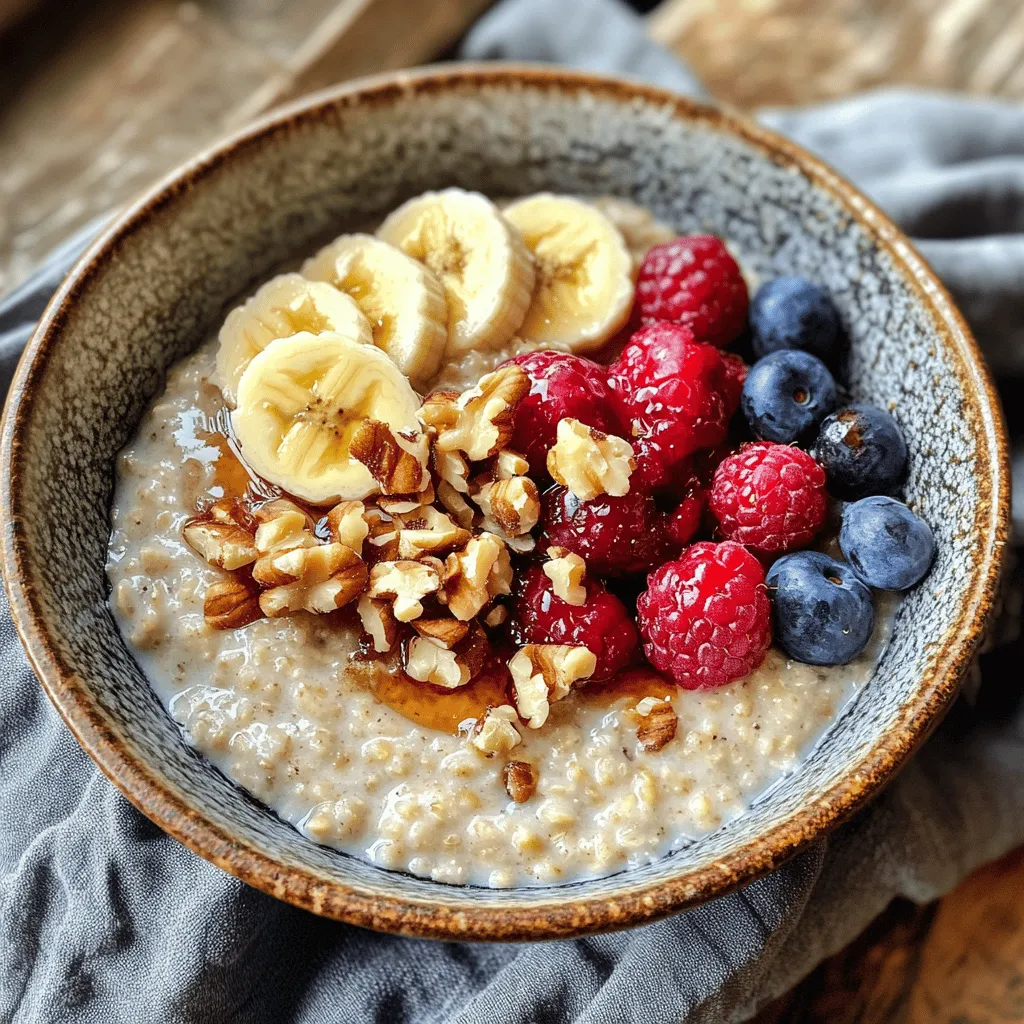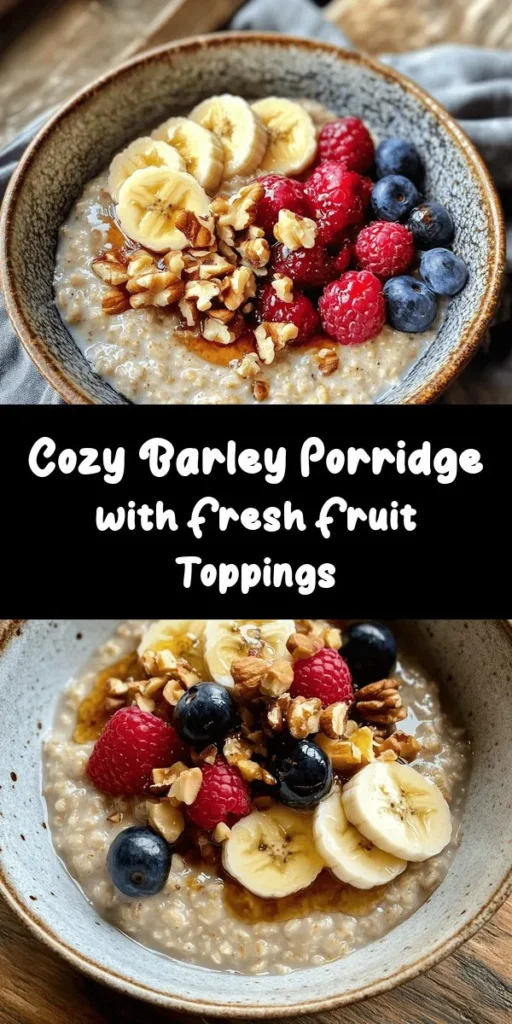When it comes to wholesome breakfast options, barley porridge stands out as a nutritious and comforting choice. Not only is barley one of the oldest cultivated grains, but it also offers numerous health benefits that make it a perfect addition to your morning routine. Packed with fiber, vitamins, and minerals, this versatile grain can be transformed into a warm and satisfying porridge that is not only delicious but also incredibly nourishing.
In this article, we aim to provide a comprehensive recipe for warm and wholesome barley porridge, along with nutritional insights and serving suggestions that will inspire you to make it a staple in your kitchen. Whether you enjoy it as a heartwarming breakfast or a nutritious snack, this porridge is bound to become a favorite for its comforting nature and wholesome ingredients.
Understanding Barley: A Nutritional Powerhouse
Barley is a whole grain that has been a dietary staple across various cultures for centuries. Its rich history can be traced back to ancient civilizations, where it was used not only as food but also in brewing and as animal feed. Today, barley remains a popular ingredient in many cuisines around the world, thanks to its unique flavor and impressive nutritional profile.
One of the standout features of barley is its high fiber content. A single serving of cooked barley provides an ample dose of soluble and insoluble fiber, which helps to promote healthy digestion and maintain stable blood sugar levels. In addition to fiber, barley is also rich in essential vitamins and minerals, including B vitamins, iron, magnesium, and selenium, all of which play vital roles in the body’s overall health.
When comparing barley to other grains, it’s essential to distinguish between the various types available. Pearl barley, for instance, has been polished to remove the bran layer, resulting in a softer texture and quicker cooking time. While it may lack some of the nutrients found in whole barley, pearl barley still retains a significant portion of its health benefits, making it an excellent choice for creamy porridge.
Ingredients Breakdown
Creating the perfect bowl of barley porridge requires careful selection of ingredients, each contributing to the overall flavor and nutritional value of the dish. Here’s a detailed look at the key components of this wholesome recipe:
Pearl Barley
The star ingredient of this porridge is pearl barley, which is known for its chewy texture and nutty flavor. Although it is less nutritious than whole barley, pearl barley is still packed with fiber and protein, making it a great base for your porridge. It cooks relatively quickly compared to other whole grains, making it an ideal choice for busy mornings.
Water or Milk
When preparing barley porridge, you have the option to use either water or milk as your cooking liquid. Using water will create a lighter dish, while milk (dairy or plant-based) adds creaminess and richness. The choice ultimately depends on your dietary preferences and desired flavor. For added nutrition, consider using fortified plant-based milks that provide extra vitamins and minerals.
Salt
A pinch of salt is crucial for enhancing the flavors of the porridge. While it may seem counterintuitive to add salt to a sweet dish, it helps balance the flavors, allowing the natural sweetness of the barley and any added sweeteners to shine through.
Sweeteners
To add a touch of sweetness to your porridge, you can choose from a variety of sweeteners. Maple syrup and honey are popular choices, each offering distinct flavors and health benefits. Maple syrup, for example, is rich in antioxidants and has a lower glycemic index than refined sugars. Honey, on the other hand, boasts antibacterial properties and can provide a soothing effect on the throat. If you’re looking for alternatives, consider using agave syrup, stevia, or even mashed bananas to achieve the desired sweetness.
Flavor Enhancers
Enhancing the flavor of your barley porridge is easy with the addition of a few key ingredients. Vanilla extract adds a warm and inviting aroma, while cinnamon contributes a delightful spice that pairs beautifully with the nutty taste of barley. Both ingredients not only elevate the flavor profile but also offer their own health benefits, such as antioxidant properties.
Toppings
To make your barley porridge even more nourishing and satisfying, consider adding a variety of toppings. Fresh fruits like berries, bananas, or apples provide natural sweetness and a burst of vitamins. Nuts and seeds, such as almonds or chia seeds, add healthy fats and protein, making your porridge more filling. For a creamy element, a dollop of yogurt or a spoonful of nut butter can take your dish to the next level, providing additional protein and flavor.
Step-by-Step Preparation of Barley Porridge
Now that we’ve covered the ingredients, let’s dive into the step-by-step process of preparing warm and wholesome barley porridge. Follow these clear and detailed instructions for a perfect bowl every time.
Rinsing the Barley
Before cooking, it’s essential to rinse the pearl barley thoroughly. This step helps remove any dust or impurities that may be present. Place the barley in a fine-mesh strainer and rinse it under cold running water for a couple of minutes. This not only cleans the grain but also helps it cook more evenly.
Cooking Process
1. Boil the Liquid: In a medium saucepan, combine 1 cup of rinsed pearl barley with 3 cups of water or milk. Bring the mixture to a boil over medium-high heat.
2. Simmer: Once boiling, reduce the heat to low and cover the saucepan. Let it simmer gently for about 30-40 minutes, or until the barley is tender and has absorbed most of the liquid. Stir occasionally to prevent sticking and ensure even cooking.
3. Check for Texture: After the cooking time, check the barley for doneness. It should be soft with a slight chewiness. If you prefer a creamier porridge, you can add a bit more liquid and continue cooking until you reach your desired consistency.
Flavoring the Porridge
Once your barley is cooked to perfection, it’s time to enhance its flavor.
– Incorporate Sweeteners: Add your choice of sweetener, starting with a tablespoon of maple syrup or honey. Stir well to combine, adjusting the sweetness according to your taste preference.
– Add Spices: Sprinkle in a dash of cinnamon and a splash of vanilla extract. Stir until everything is well mixed, allowing the flavors to meld beautifully.
Adjusting Consistency
If you find that your porridge is thicker than you like, simply stir in a little extra water or milk to loosen it up. Conversely, if it’s too runny, you can cook it a bit longer to thicken. The key is to adjust according to your personal preference for texture—whether you enjoy it creamy or more porridge-like.
Stay tuned for the next part of this article, where we will explore serving suggestions and additional tips for making your barley porridge truly exceptional.

Serving Suggestions and Variations
Barley porridge is not just a nutritious breakfast option; it is incredibly versatile and can be adapted to suit a variety of palates and dietary preferences. Here are some creative ideas for serving barley porridge, along with variations to keep your meals exciting.
Ideas for Serving Barley Porridge
1. Breakfast Bowl: Serve barley porridge warm, topped with a splash of milk or a dairy-free alternative and a sprinkle of cinnamon. Add sliced bananas, chopped nuts, and a drizzle of honey or maple syrup for a truly satisfying start to the day.
2. Brunch Delight: Elevate your barley porridge by serving it alongside poached eggs and sautéed greens for a hearty brunch. The combination of creamy porridge with runny eggs creates a delightful texture contrast.
3. Healthy Snack: Enjoy barley porridge as a snack by preparing it with water or a nut milk, then topping it with a dollop of yogurt and fresh berries. This makes for a perfect afternoon pick-me-up that is both wholesome and filling.
Variations to the Basic Recipe
1. Savory Options: For a savory twist, consider incorporating sautéed vegetables such as spinach, mushrooms, or bell peppers into your barley porridge. Add a sprinkle of cheese, such as feta or Parmesan, for creaminess and flavor. A pinch of black pepper or chili flakes can also enhance the dish.
2. Seasonal Toppings: Make the most of seasonal produce by adapting your toppings. In spring, try fresh strawberries and almonds; in summer, use peaches and toasted coconut. Fall is perfect for apple slices and walnuts, while winter can feature citrus segments and pomegranate seeds.
3. Dietary Adaptations: Barley porridge can easily be modified to accommodate various dietary needs. For a vegan version, use almond milk or coconut milk instead of dairy. Gluten-free eaters can substitute barley with quinoa or rice flakes, and those looking for higher protein content can stir in Greek yogurt or protein powder just before serving.
Health Benefits of Barley Porridge
Barley porridge is not only a comforting dish but also a powerhouse of nutrition that can significantly contribute to a balanced diet. Here’s how barley promotes overall health:
Fiber and Digestion
One of the standout benefits of barley is its high fiber content. A single serving of barley porridge delivers an impressive amount of soluble and insoluble fiber, which plays a crucial role in digestive health. Fiber aids in maintaining regular bowel movements, prevents constipation, and fosters a healthy gut microbiome. Additionally, the fiber in barley can help you feel fuller longer, making it an excellent choice for weight management.
Blood Sugar Management
Barley is a whole grain with a low glycemic index, which means it releases glucose slowly into the bloodstream. This property is particularly beneficial for individuals managing blood sugar levels, as it helps prevent spikes and crashes. Incorporating barley porridge into your diet can support stable energy levels, making it a smart choice for those with diabetes or anyone looking to maintain consistent energy throughout the day.
Heart Health
Regular consumption of whole grains like barley has been linked to improved cardiovascular health. The soluble fiber in barley helps reduce cholesterol levels, while the grain’s rich array of vitamins, minerals, and antioxidants can contribute to overall heart health. By incorporating barley porridge into your meals, you’re taking a proactive step toward a heart-healthy lifestyle.
Sustainability and Ethical Considerations
In recent years, the conversation around sustainability in food production has gained momentum, and barley stands out as an environmentally friendly grain choice. Here’s an exploration of why barley is a sustainable option:
Environmental Impact of Barley Farming
Barley is resilient and adaptable, requiring less water than many other grains, making it a more sustainable crop. It can thrive in various soil types and climates, thereby reducing the need for intensive agricultural practices that can harm the environment. By choosing barley, consumers can help promote sustainable farming practices.
Supporting Local Farmers
Choosing locally sourced barley not only supports regional economies but also reduces the carbon footprint associated with transportation. Look for products labeled as organic or sustainably grown, as these often come from farms that prioritize environmentally friendly practices and ethical treatment of workers.
Cultural Significance of Porridge
Porridge has a rich history across various cultures, and barley porridge is no exception. Understanding its cultural significance adds depth to your meal.
Historical Context
For centuries, porridge has served as a staple food in many societies around the globe. In ancient times, barley was one of the first cultivated grains, playing a significant role in the diets of early civilizations. From the Scottish oatmeal to the Asian congee, variations of porridge are found in nearly every culture, often served as a nourishing meal for families.
Comparison to Other Traditional Porridges
While barley porridge is celebrated for its health benefits, it stands shoulder to shoulder with other traditional grains such as oats, rice, and cornmeal. Each grain offers unique flavors and textures, but barley’s nutty profile and chewy consistency make it a distinctive choice. Many cultures have adapted the basic porridge concept to include local ingredients, enhancing its versatility.
Evolution in Contemporary Cuisine
In recent years, porridge has made a comeback in health-focused diets, with chefs and home cooks alike embracing its potential. Today, barley porridge is not just a breakfast staple but also features in gourmet dishes, food blogs, and health food cafés, highlighting its adaptability in modern cuisine.
Conclusion
Warm and wholesome barley porridge is a versatile dish that offers both nutritional benefits and culinary creativity. Whether enjoyed as a comforting breakfast, a hearty brunch, or a nutritious snack, barley porridge can easily adapt to suit your tastes and dietary needs. With its rich fiber content, ability to stabilize blood sugar, and heart-healthy properties, incorporating barley into your daily meals can pave the way for a healthier lifestyle.
As you explore the world of barley porridge, you not only embrace a nourishing meal but also engage with a grain that carries historical significance and sustainability. So, gather your ingredients, get creative with toppings, and take joy in cooking and sharing this delightful dish with loved ones.



